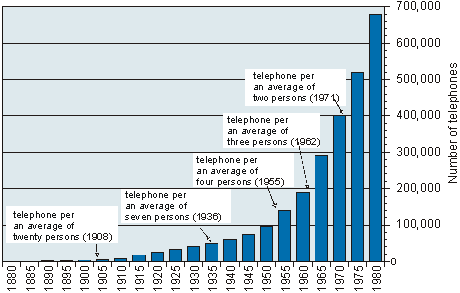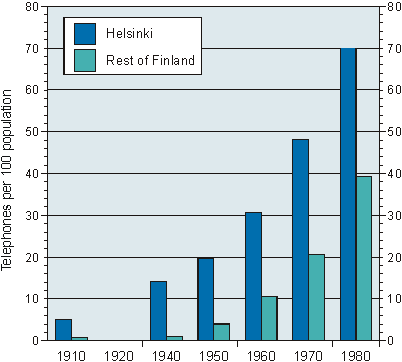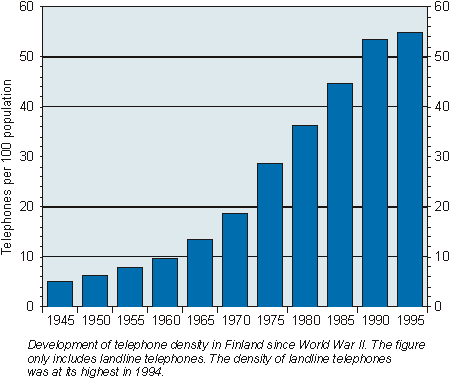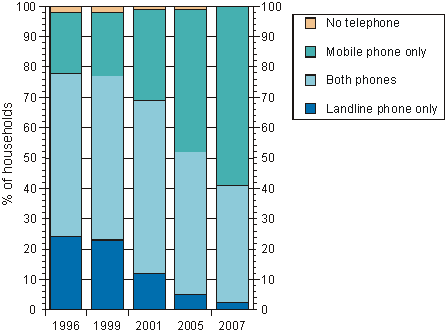From hand-cranked connections to hands-free mobile calls - history of telecommunications in Finland seen through statistics
Despite their reputation of being reticent, the Finns have been among the forerunners in the world in the use of the telephone. The first telephone line was erected in Helsinki towards the end of 1877; only 18 months after the telephone had been patented in the United States. Mobile phones, too, made their penetration in Finland much earlier and more quickly than in any other country in the world.
When the telephone was invented, Finland was an autonomous Grand Duchy of Russia. The Telegraph Office of Finland was controlled by Russian officials but it was not clear who should administer telephony. In particular, it was unclear who should grant licences to practice telephony. Thus, the Finnish Senate decided that these matters came under its jurisdiction and Tsar Alexander III endorsed the decision. In consequence of the Senate's decision, regional telephone companies were established across Finland and a competitive telecommunications market was born in the country. The first telephone company was founded in Helsinki in 1882, and by the Second World War a total of 815 local telephone companies had been set up in Finland. In most other countries telephony was regarded as a successor to telegraphy and hence became a state monopoly.
In the early days statistics on telephony were only compiled at a handful of localities, or they have not survived the time. There are only a couple of publications on the history of telephony in Finland and no exhaustive information covering the whole country exists on it. Figure 1 shows how the number of telephones grew in Helsinki during a century starting from 1880.
Figure 1. Growth in the number of telephones in the Helsinki Telephone Association's operating area from 1880 to 1980

Source data for the figure derive from the history of Helsinki Telephone Association written by O. Turpeinen (Turpeinen, 1981).
Telephones first arrived in the largest towns, then gradually spread to smaller towns and the surrounding countryside. In urban areas telephones grew common quite rapidly. At the turn of the century Helsinki had 3.3 phones per 100 population, which was considerably more than in other towns. Even later on telephone density continued to be higher in Helsinki than elsewhere in the country. Figure 2 shows that the difference between Helsinki and the rest of the country has been narrowing but even as late as in 1980 there were almost twice as many telephones per 100 population in Helsinki as in the rest of the country.
Figure 2. Development of telephone density in Helsinki and in the rest of the country, 1910-1980

Source: Turpeinen, 1981.
Telegraphy was important during early independence
It may seem surprising today that at the beginning of last century the telegraph network of the State Railways was considerably more extensive than that of the Telegraph Office. In 1918, the State Railways owned 304 telegraph offices that were also open to the general public, whereas the Telegraph Office had only 76 offices of which 66 were independent and the rest auxiliary offices. In 1919, the telegraph offices of the State Railways transmitted a total of 64,146 telegrams - presumably for the general public - whereas the Telegraph Office's offices sent 373,893 telegrams to domestic recipients and 364,472 abroad. However, the volumes of their transmissions cannot be properly compared because telegrams relating to the Railways' own activities, like telegraph traffic between railway stations, were obviously not included in the statistics. The scope of this activity was most likely significant, especially taking into consideration the fact that the telegraph was almost the only means by which railway stations could communicate with each other.
Besides the volume of traffic, for many years the infrastructure for telegraphy was also described in considerable detail in statistics. In addition to describing the transmission volumes of telegraph offices, the statistics also contained information on the total line lengths of the State Railways and the Telegraph Office, as well as on the lengths of overhead pole lines according to whether they ran along highways or railways, and on the lengths of cable lines.
Equally detailed statistics were compiled on the infrastructure of the State's telephony. In addition to the number of exchanges they also contained data on the lengths of pole and cable lines. The overhead pole lines were even classified by quality into ferrous, copper and double wire lines. The numbers of calls (or more rightly impulses) were itemised into calls by state authorities and private persons. Private calls were additionally classified into simple and urgent ones, and calls of the press.
Data on the activities of the State telegraph and telephone companies were published in the Statistical Yearbook of Finland from 1924 onwards. However, some data on their activities were available in 1924 starting from 1918. At first the statistics contained much more, and more detailed, data on telegraphy than on telephony. The tables describing telegraphy contained a total of 42 columns per one year but the ones describing telephony had only 17 columns.
Private telephone companies were not covered by statistics until the 1930s
Up to 1932, the Statistical Yearbook of Finland only contained data concerning the telephony and telegraphy activities of the State. Data describing the activities of private telephone companies were not published in the Yearbook until 1932.
Measured with any indicators, private telephony activity was many times more extensive than that of the State. For example, in 1932 State telephone companies had 227 exchanges whereas private telephone companies had as many as 1,998 of them. Likewise, in the same year the State had 1,763 "subscriber apparatuses" but private telephone companies had 133,456.
The compilation method of the statistics remained relatively unchanged for decades, but the emphasis in them was gradually shifted from telegraphy to telephony. Moreover, little by little descriptions of infrastructure gave way to descriptions of telecommunications traffic. Radio communication was added to the scope of the statistics in the 1950. Descriptions of infrastructure were only dropped from the statistics in recent years.
Data concerning mobile phones were added to the Statistical Yearbook of Finland in 1990, concurrently with data on transmissions networks. However, the data went back to 1980, when the manual ARP (Auto-Radio-Puhelin=car radiotelephone) network, the first Finnish mobile communication system intended for wide general use, had 23,482 subscribers. The automatic NMT 450 network (NMT=Nordic Mobile Telephone) first appeared in the statistics in 1982 (2,648 subscriptions) and the NMT 900 network in 1987 (2,038 subscriptions). The capacities of the NMT networks grew rapidly in the 1980s. For instance, the number of subscriptions in the NMT 900 network increased 20-fold in two years.
Compilation of statistics on telecommunications is challenging
Like so many other fields, telecommunications and communications have changed dramatically during Finland' independence. Innovations that have become part of everyday life are added to the scope of statistics with a delay. The focus in the statistics has also shifted so much over time that comparable data on the development of communications cannot be presented for the whole 90-year period of Finland's independence.
Describing of telephone coverage and telecommunications is problematic in many ways. Early figures depicting the penetration of the telephone are somewhat misleading. As a rule they portray the number of telephone subscriptions or telephones per 100 population. An indicative figure like this changes as the numbers of telephones and inhabitants change, and the population of the operating area of the Helsinki Telephone Association, for instance, has at times grown considerably fast.
A further problem is that the parameter figure describing landline telephones should indicate the number of telephones per household or dwelling unit. The landline telephone is an appliance typically serving a household - even more so in the past than today. However, such parameters cannot be calculated from the early days of telephony because statistical figures were not compiled on the numbers of households in Finland until the 1950s. Presumably, in the early part of last century the average size of a household was essentially larger than today: there were more households relative to the whole population, therefore a smaller number of telephones served a larger population than today. By contrast, the mobile phone is a personal appliance, therefore its penetration should be described in relation to the total number of population.
Mobile phones changed the structure of telephone coverage
As late as in the early 1990s, telephone coverage was usually calculated from the number of subscriptions reported by telephone companies and the number of households or inhabitants reported by Statistics Finland. Figure 3 describes how the telephone coverage has changed in Finland. This calculation method is still used in many countries. However, in the era of the mobile phone figures obtained like this are quite unreliable, especially in countries where pre-paid subscriptions are popular. Many of these countries report well over one hundred per cent telephone coverage of households (see Kuusela et al. 2007). In order to produce a more reliable picture, from around the middle of last decade Statistics Finland began to study telephone coverage in Finland with interview surveys. Since then, relatively accurate data have been available on the telephone coverage, and its structure and changes in Finland (see Kuusela, 1997 and Kuusela, 2000).
Figure 3. Development of the density of landline telephones in Finland since World War II

The number of landline telephones was at its highest in Finnish households in the first half of the 1990s. In 1993, 94 per cent of all households in Finland had at least one landline telephone. Mobile phones were already making a strong entry and especially when the GSM network became widely available the number of landline telephones started to fall in households. As far back as in July 1999, more households already had a mobile phone than a landline telephone and the difference has been growing ever since. In August 2007, only 41 per cent of households still had a landline telephone while 97 per cent had at least one mobile phone. In consequence of the penetration of the mobile phone, households without any telephone have disappeared almost entirely from Finland. Figure 4 shows how the structure of the telephone coverage has changed in Finnish households in one decade.
Figure 4. Change of telephone coverage in households 1996-2007

In 2007, practically every person of working age in Finland has a mobile phone. Only the very oldest persons, especially women, have fewer mobile phones than others. In two households out of three, every household member has their own mobile phone.
The number of households with no landline phone has been growing rapidly. In the 1990s, such households were born when young people established their own households and decided not to get a landline connection. Moving home was another reason for their emergence: landline connection was no longer acquired to the new home even if there had been one in the old one. During this decade, more and more landline subscriptions have been terminated even in cases where no change of dwelling was involved. It may not be that far-fetched a future vision that before long all telephone communications will move over to wireless devices. At the latest, this could be foreseen to happen when today's middle-aged population reaches old age.
Inquiries: Vesa Kuusela +359 9 1734 2380
Sources and links
- Home pages of telecommunication statistics
- Turpeinen, O.: Helsingin seudun puhelinlaitos 1882-1982 (Helsinki Telephone Corporation 1882-1982; in Finnish only). Helsinki Telephone Association, 1981.
- Kuusela, V.: Puhelinpeittävyys ja puhelimella tavoitettavuus Suomessa (Telephone coverage and accessibility by telephone in Finland; in Finnish only). Statistics Finland. Reviews 1997/1.
- Kuusela, V.: Puhelinpeittävyyden muutos Suomessa (Change of telephone coverage in Finland; in Finnish only). Statistics Finland. Reviews 2000/3.
- Kuusela, V., Callegaro, M., Vehovar, V.: The Influence of Mobile Telephones on Telephone Surveys. In Lepkowski, J. M., Tucker, C., Brick, J. M., de Leeuw, E., Japec, L., Lavrakas, P.J., Link, M. W., Sangster, L. (Eds): Advances in Telephone Survey Methodology. Wiley 2007.
Last updated 24.9.2007
